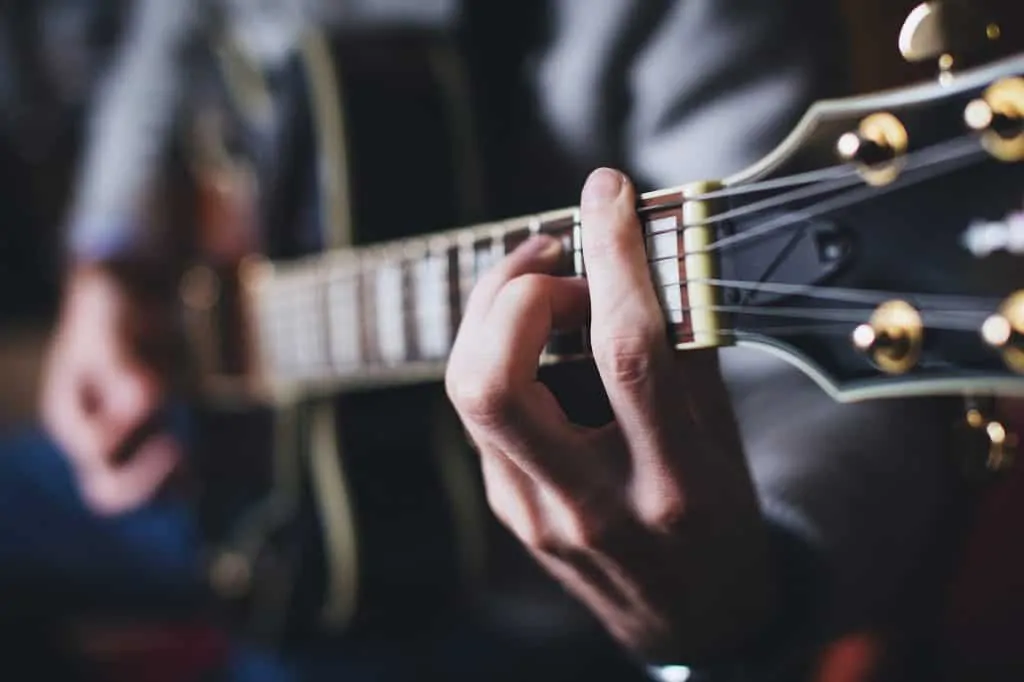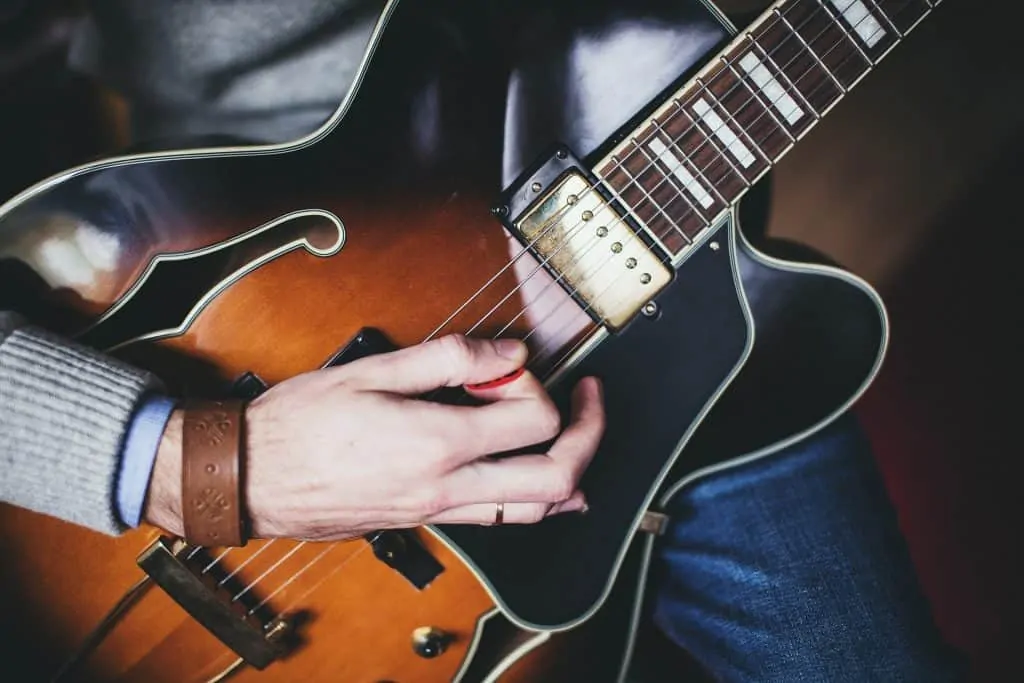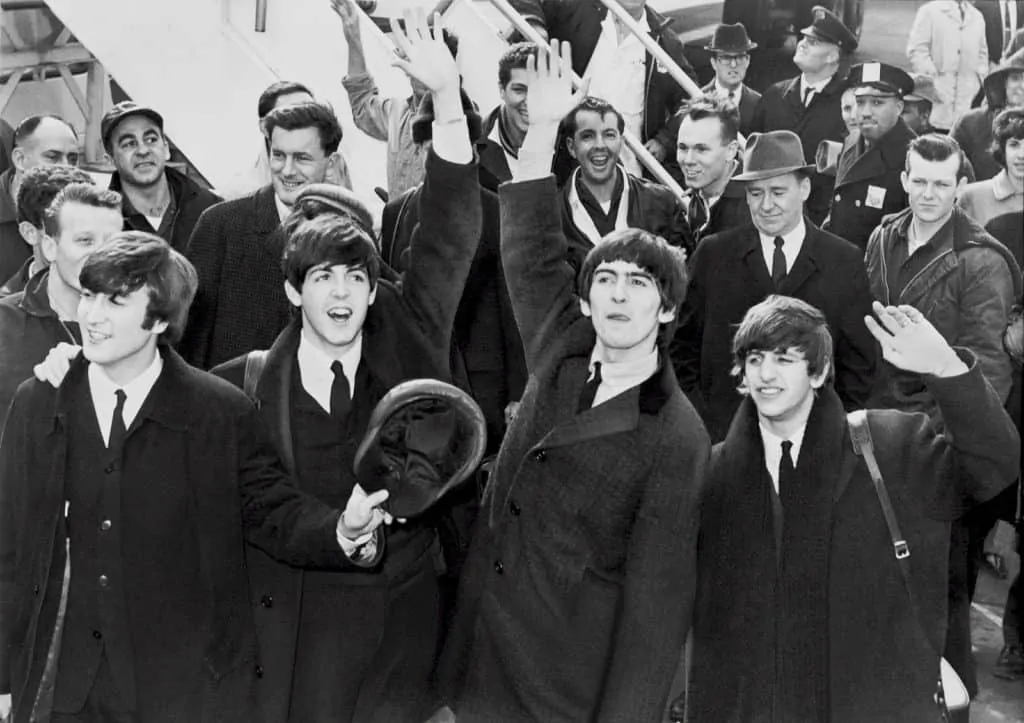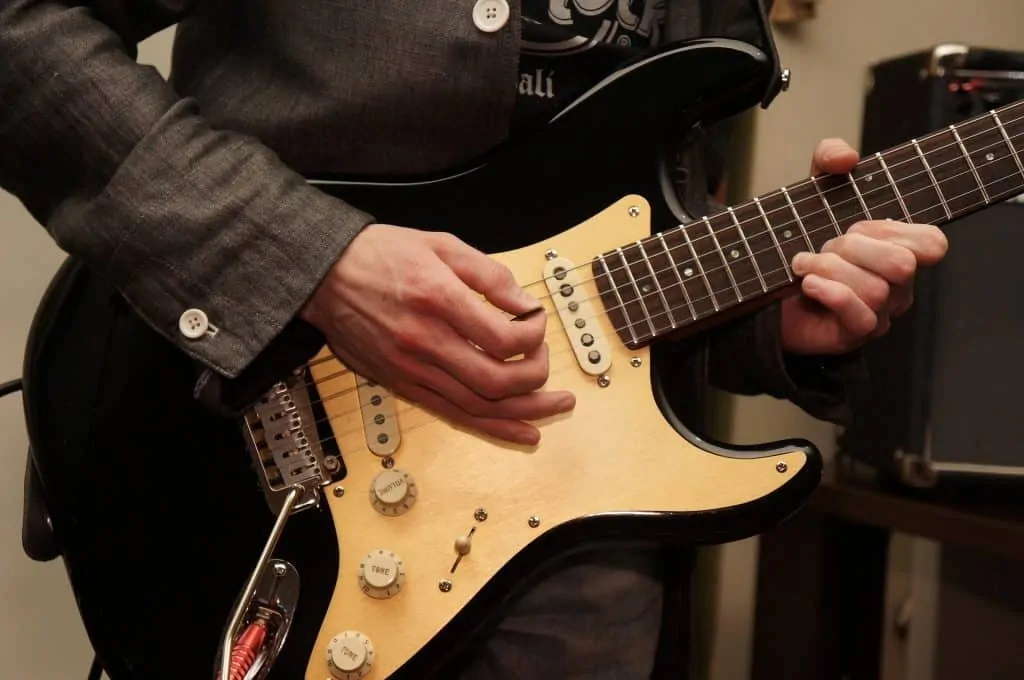Most guitarists begin to play the instrument because they want to play like their guitar heroes. Maybe it’s just one particular song, or maybe it’s their whole discography. Regardless, every player has their own particular idols, whose sounds we emulate and styles we copy.
As your skills improve, you may find yourself playing and mastering your guitar hero’s songs. And while it’s a massive accomplishment, in many ways it’s only the beginning of a new journey: the journey to developing your own guitar playing style.
Developing your own guitar style is a process that can take years. For most players, it’s also a process that never truly ends — even the greatest guitarists in history continue to add new tricks to their arsenal of riffs and experiment with different methods of playing the instrument.
Contents
Active vs. Passive
Unfortunately, many beginners regard creating their own style as a passive process rather than an active one. Waiting around until a unique riff pops into your head or until a heretofore unheard-of chord falls under your fingers makes your daily playing routine much less complicated, but it hamstrings you from expressing your own voice on the instrument.
Over time, that built-up passive mentality leads many players to assume that they simply can’t play in a unique way. If it hasn’t happened yet naturally, the thinking states, it’s not going to happen at all. As pervasive as it might be, that line of thinking couldn’t be further from the truth.
No player is born playing solos and rhythms that nobody has ever heard before. Learning to play the guitar in your own unique manner requires an active investment in your creativity and deliberate research on your own playing habits. Without putting in the time to become original, you’ll never stand a chance of developing a signature style.
As you read the rest of this article, remember to keep that “active mentality” in mind. Don’t shy away from the work, even if it may feel unnatural at points. In the end, you’ll come out the other side with a better understanding of how you play, where you can improve, and what technical and ideological steps you can take to separate your playing style from the rest of the pack.
Your individual playing style will be influenced by your preferred genres of music.
Genre
Creating your own unique playing style depends heavily on the genre you play in. What is unique in one genre is probably standard in another — oftentimes some of the most inventive or original guitar players in history simply incorporated the most disparate influences into their playing.
With that in mind, your first step to becoming a more original player should be to consider the standards and norms of the genre (or genres) you play in most frequently. Think about the most common techniques, chords, riffs, and cliches in each of those genres. Listen to some of the greatest hits in each genre and try to pick out those most common features.
Your goal in this practice exercise doesn’t necessarily need to be eliminating those cliches from your playing entirely. There’s a reason certain patterns and progressions become genre cliches: because they sound good. However, developing your ability to hear a few of the most common structures in other players’ styles will help you identify the same patterns in your own playing.
Once you’ve found your genre’s most common cliches, you can do a few different things with them. As mentioned above, your first strategy should be to listen to your own playing, then isolate and cut back on your use of those cliches.
A great example is the high bend at the top of the pentatonic scale — a vintage blues turnaround cliche. While it may sound incredible if used correctly, many amateur blues players resort to using this bend over and over in their solos; oftentimes they end up sounding like an imitation of blues legends than a skilled player in their own right.
However, cliches can also be your first step to separating your own playing from a more generic style. As you examine your genre to find its most common cliches, look for their most common locations as well. Then, deliberately alter one aspect of the cliche — the pattern or the timing — when you use it in your playing.
This method is a great starting point for players looking for an easy way to differentiate themselves. Altering the sequence of a common guitar lick, changing the order of chords in a common progression, or simply playing a cliche at an unexpected time can help you sound good while skirting the bland, uninspiring feeling many cliches evoke.
Providing the audience with a slightly shifted version of a common sound will also make your playing feel recognizable without sounding too familiar or hackneyed.
Continuing with our example of the 12-bar blues bend from above, we could analyze the typical sequence and timing of bending licks. Most blues guitarists play a high pentatonic bend at the end of a lick or solo, and play it as a sort of “climax” that can take up lots of space in a typical measure.
To turn it on its ear, you could change any number of different aspects. You might include a brief, snappy bend at the beginning of a longer lick. You could play the high bend as part of a different scale than the minor pentatonic, providing a recognizable sound but with a different harmonic color. You could even prebend the note and play it coming down, rather than the traditional upward bend so many guitarists use.
These small tricks are the first step you can take to slowly developing your own guitar style while remaining focused within your specific genre. Applying this process with genres you don’t normally play can help you incorporate more unusual sounds into your playing style.
Your typical sound — or the typical sound you find in your favorite genres — can also be another area where you innovate. Do you listen to styles that love overdrive pedals, like punk rock, grunge guitar, blues, or classic rock? Are you into cleaner indie and rock and roll?
Experiment with the various pedals and sounds artists in your favorite genres use. Maybe you can add a new tone to the mix, or apply classic sounds from one style to play a different type of music.
Looking to outside genres for inspiration is a classic tradition for guitarists throughout history. In these cases, you often don’t even need to rework the cliches to put them in your own playing — while these phrases may be common in one genre, bringing them into another style gives them a fresh new sound and lends your playing a unique fusion feel.
Playing with other people — especially players that influence you — can help you discover what makes your style unique.
Influences
After examining your preferred genre, you should look to your main playing influences. Who were your first heroes when you picked up the guitar? Which players do you look to emulate when you sit down to play?
Chances are, you’ll probably already know certain key features of their styles; your first guitar heroes tend to be strong influences to your own playing and improvisation. Much like how you can analyze your genre for cliches and common lines, you should also look to your own influences for techniques.
When researching your influences, it’s best to listen to a wide variety of tracks from different sections of an artist’s career. For example, George Harrison’s straight-ahead rock and roll work on “I Saw Her Standing There” is much different from his slinky, understated style in “Something.” Examine songs across multiple eras and albums to get a better idea for what items Harrison (and other artists) employ the most in their playing.
A great way to start out with this process is to identify the most common keys your influences like to play in. From that key, which chords do they include in a progression? How many chords? What voicings do they use? Do they prefer extended chords?
When looking at solos, you can apply a similar process: as you transcribe, ask yourself questions and dig deeper to find more patterns. What scales do your favorite artists tend to solo in? Are there any notes they land their licks on? Do they bend or slide into any notes in particular? What’s their time feel like during the solo?
All these questions will help you better incorporate their songwriting and guitar playing skills into your own work down the line. They’re also just a small sample of the possible ways you can dig into an artist’s work to uncover more meaning. Look for classic tools songwriters use like melody, harmony (instrumental harmony but more typically vocal harmony), and rhythm.
Simply playing through a bunch of a certain artist’s catalogue is another strategy to develop a better ear for their most common techniques. As you play, you’ll be able to hear their stock moves more clearly in a mix and use them in songs or solos of your own.
Playing will also strengthen both your choral and your soloing work. The more songs you study by one particular artist, the more they can help bring the best out of you as a guitarist and songwriter.
Make sure that you do this with multiple different guitarists who ideally play different styles. Each player has something to offer in their style, but analyzing five different blues players will reveal less than analyzing one blues player, a jazz player, a punk player, an indie player, and a country player.
Push yourself to listen to new and unusual guitarists; if their work appeals to you, follow the process above to uncover what makes them tick. Make a note of the key concepts and techniques they use in their playing, then you’re free to apply it to your own work.
Synthesizing these multiple influences is the same way many of the world’s greatest guitarists developed. As you integrate different facets of each one into your playing, your style will become more unique. Making a conscious effort to utilize techniques from different genres into your improvisation and chord progressions will speed up this process.
Chords and concrete techniques are the foundation of any player’s individual style.
Techniques
Beyond imitating broader genre characteristics and extracting the favorite tricks of your guitar heroes, you should also focus on finding new and creative licks and snippets to deploy in your soloing and songwriting progressions.
While your influences may be your preferred sources of playing techniques — there’s certainly some degree of overlap between studying a certain artist and studying specific techniques — searching for concrete techniques requires a much wider scope and a willingness to draw from all different sources for inspiration.
That may mean searching outside of your favorite genres to truly analyze different techniques, or it may mean listening to musicians who play instruments besides guitar. For example: famous jazz guitarist Grant Green was known for listening to horn players nearly exclusively; as a result of his unconventional influences he developed a one-of-a-kind soloing style built around single-note lines reminiscent of saxophone or trumpet licks.
In fact, jazz in general is practically a sea of outstanding techniques and licks for guitar, whether originally created by guitarists or other instrumentalists. Harnessing these techniques may be difficult but the process can set your style apart from other players before you even put these licks into your own solos.
Transcription is the best method to use to learn the vast majority of these techniques. The ear training can be a slog if you don’t feel up to the task, but working out these techniques in a natural way allows you to formulate the most natural way to play each technique for yourself.
Rather than struggling to play a lick based on a tab at one specific spot on the neck, transcribing the licks gives you the freedom to play the technique wherever feels best for you. As an added bonus, the practice required to successfully transcribe any piece of music will lock that technique more securely into your mind and will give you a head start on how to adapt it to make it your own.
Transcribing a solo is often tricky and hard to hear — first stabs at getting the notes of a certain passage almost inevitably include mistakes. But these mistakes, coincidentally, can be great licks in their own right. As the concept of a specific solo forms in a player’s head, ingrained mistakes may show up — this is another opportunity to take the work of another guitarist and truly make it your own.
The most common form of a “technique” to adopt is a lick or improvisation idea that a certain player loves to come back to. In practice, however, a technique may also be a trademark sound caused by a mechanical technique– like Mark Knopfler’s fingerstyle playing, Jimi Hendrix’s thumb barre chords, or James Burton’s chicken pickin’.
Seemingly insignificant changes to your mechanics, like whether or not you palm-mute the strings, where you place the thumb of your fretting hand, or where you hold your hand over the guitar when you play can all have drastic effects on your sound and playing ability. If you spot any players with unusual mechanics that they utilize to produce a unique sound, consider trying it out to get a feel for whether or not you could adapt the same technique.
It’s important to remember that many musicians, even professional ones, don’t have perfect technique! You shouldn’t copy just any style you see on stage without any analysis — you may end up playing in a less effective manner or even risking injury thanks to improper form. Be careful when imitating the mechanical techniques of other players and only keep playing in that manner if it’s comfortable and helps you improve on your skills as a guitarist.
Feel and presence are nearly as important as your chops when playing in front of an audience.
Style, Feel, and Stage Presence
Nearly as important as concrete techniques are your style and feel while playing. Each guitarist’s style contributes to their playing techniques in some way, from B.B. King’s soulful butterfly vibrato to Pete Townshend’s ferocious, take-no-prisoners windmill strumming technique.
Much of this comes from each artist’s personality; creating your own style when playing in the studio and on stage will differentiate your sound from other players in the same genre.
It’s important that at least some of your style develop naturally. Faking a character when playing or forcing yourself into a contrived personality for purposes of “feel” is likely to just end up feeling uncomfortable and stiff (unless you’re David Bowie).
Your style will determine how you comport yourself on stage, how you hold the guitar, how you strum and how you inflect certain notes. It can be difficult to create your own style if you only play in your room without an audience — at the very least, try to set up some jam sessions with friends who play other instruments or local musicians to get some more experience playing in groups. Open mic nights are another great option.
Look at how you naturally behave on stage when you play for other people. If you’re like most players, chances are you may feel timid or nervous of mistakes at first; it’s completely natural for newer or less experienced gigging players to initially shy away from the spotlight.
Now compare that with how you want to act on stage. Most guitarists (though not all) would like to be able to move around the stage more, interact with audience members, and carry themselves with more guitar hero swagger.
This is another opportunity to examine how your idols conducted themselves — were they more stationary, or did they move around? Did they play extremely aggressively, or were they more relaxed? Did they approach each gig with a predetermined mindset, or would they change their mood and style throughout the course of the show?
Even if you just want to project more confidence on stage and stop focusing only on your instrument when you play, looking to your idols is a smart strategy to move towards your goals. Take a piece of each artist’s stage presence to create your own unique synthesis.
Once again, though, it’s important that you preserve your own natural personality. Resist any cheap imitations of your favorite players, no matter how tempting it may be — it’s harder to gain respect for your own songs and your own playing style if you copy another player’s stage act!
Creativity often comes as a result of practice and guitar knowledge.
Creativity
Creativity is key to any unique guitar player. And though incorporating different techniques from your favorite artists and genres may help you stand out among other players in a specific sense, truly great guitarists create their own new riffs and progressions.
If you have trouble coming up with any new ideas when you sit down to play guitar, it can be helpful to do a few exercises to warm up first.
A great way to ease yourself into the creative process is to put yourself into the shoes of your favorite artists. Rather than taking their licks as they played them, try to create a new lick that resembles their guitar style. Imagine you’re playing their music, then practice coming up with something new that employs a couple of their signature techniques.
The same process works with chord progressions as well. If you’ve studied the chords your favorite artists like to use the most, try to combine a few of them in a progression they haven’t recorded before. You could also use different voicings or extensions of these chords for a more uncommon feel.
As you grow more comfortable riffing off your idols’ styles, you can begin cutting back on the overt influences you work in and start relying more on your own creativity. Use chords or notes that catch your ear, and explore different areas of the neck to find your ideas. Switch up what you normally play in order to create something more fresh.
Though it might seem counterintuitive, deliberately imposing these sorts of limits on your playing can stimulate your creativity. Forcing yourself to play notes outside of your usual “wheelhouse” can be the best way to strengthen your skills and develop an exceptional playing style.
Playing creatively becomes easier the more experienced you are, though it’s never too early to start trying. Keep at it to push through any difficulties; even the most polished pros still work in elements of their historical influences.
Historical Examples
The following are a few examples of famous guitar players throughout history and how they developed their unique styles.
Their stories all show that there’s no “magic bullet” here — each player found their own way on the instrument, and their styles didn’t spring fully formed from their heads one day. Becoming a unique player is a process, and it’s important to stick with that process even if you feel you aren’t making much progress.
The Beatles aren’t only the most popular band of all time — they were also some of the most creative guitarists in rock history.
The Beatles
The Beatles remain among the most famous musicians in the history of popular music. Their rise to fame was preceded by playing over a thousand hours of music for gigs in the German city of Hamburg. Though their influences at this stage tilted heavily towards early rock and roll artists with a hefty dose of rockabilly, one of the key features to their world-conquering sound came from a completely different source.
Vocal harmony was practically nonexistent in early rock and roll, as singers generally carried the tune on their own. The Beatles, however, learned of vocal harmony from vocal groups like the Everly Brothers and Motown girl groups like the Shirelles and the Supremes. They even reached into the Broadway scene, incorporating showtunes like “Till There Was You” into their regular set.
Even after becoming the top band in the world and spearheading the British Invasion, the Beatles continued to innovate. From 1965 onwards, they took on influences from the California sound of the Byrds and the earnest folk of Bob Dylan to more exotic Indian raga and the burgeoning psychedelic scene.
Their albums also communicated a relentless drive to innovate — even as they achieved incredible success, they continued to change their sound. Oftentimes this led to a 180-degree turn in style from album to album.
When examining how the Beatles developed their unique playing style, it’s easy to dismiss them as simply possessing virtuosic talent. Yet a closer look at their story reveals many of the hallmarks discussed above.
They listened to a wide variety of different artists across multiple different musical styles, then synthesized those influences into a unique combination of sounds and techniques. They sharpened their stage presence and developed their uniform mindset through countless hours playing in front of smaller audiences. And most importantly, they continued to integrate disparate genres into their work without sacrificing their central personality.
Obviously, The Beatles are one of a kind; no band today may ever reach their level of ubiquity. But any guitar player can use their strategies as a template to create their own playing style.
Though he revolutionized guitar music with his eponymous band, Eddie Van Halen actually began as a drummer!
Eddie Van Halen
Though his guitar style sounded nothing like that of the Beatles, Eddie Van Halen followed a similar regimen of intense practice and synthesis of his influences to create his landmark guitar style.
As a teenager, Van Halen recalled that he would practice for hours while his brothers went to parties, from seven o’clock at night to three o’clock each morning. Though he began playing the piano and initially tried out the drums before switching to the guitar, this intense practice routine rapidly improved his playing and refined his presence on stage.
Van Halen was also a noted fan of Cream, saying that he had most of their records memorized note for note. Though they would later become the biggest influence in his breakneck improvisation in Van Halen, he found his signature technique from another source: Jimmy Page.
Van Halen said that watching Page perform the solo on Led Zeppelin track “Heartbreaker” and pull off from a fretted note to an open string inspired him to begin tapping. Using his finger to replace the nut, and pulling off with his other hand, he popularized the technique that revolutionized hard rock and metal in the 1980s.
As he grew more comfortable with his tapping technique, Van Halen applied the technique to classic licks from other genres — like blues guitar triplets. A common feature of improvisations by artists like Eric Clapton, Van Halen was among the first players (if not the very first) to tap out triplets across different strings on the guitar.
In fact, many of Van Halen’s lengthy improvisations were unique to the hard rock genre at the time. In a field dominated by the short, choppy distortion of punk, Van Halen liberally incorporated scales and cliches from other genres like blues and classic rock.
Like the Beatles, Van Halen is an incredibly talented player — his playing style is one of the most recognizable in the history of the electric guitar. However, he still created the main facets of that legendary feel by analyzing and combining some of the signature techniques of his favorite players and by introducing aspects of disparate genres into the hard rock scene.
Johnny Marr’s creative guitar style propelled The Smiths to become one of the most successful bands of the 1980s.
Johnny Marr
Johnny Marr is another legendary guitarist, known best for his work with The Smiths and Modest Mouse. Marr honed his trademark style as a kid growing up in Manchester, England in the 1970s.
In contrast with the Beatles and with Eddie Van Halen, all of whom took major inspiration from blues rock and early rock and rollers, Marr intentionally steered clear of blues influences in his playing. Regarding blues and the pentatonic scale as “already done,” Marr instead found influences in early 1960s girl groups, pop rhythms, and 1970s glam rockers like T. Rex.
Marr also worked to duplicate multiple instrumental parts, from rhythm guitar to keys and vocals, with his own axe as he practiced. That training helped him incorporate playing techniques from other instruments — indeed, his playing can sometimes resemble vocal or keyboard lines more than traditional guitar parts.
The music he listened to was also instrumental in creating his distinctly non-macho stage feel. Marr steered clear of evoking the swaggering hard rockers of the 1970s, instead opting for a more reserved look that focused on his music above performance art.
By incorporating influences from different and unconventional genres into his playing, Marr created a style that redefined the purpose of the guitar for a generation and spawned genres like indie, alternative, and britpop.
Work and dedication are the most essential aspects to developing your own style. While it may be a difficult process, it’s certainly worth it in the end.
Summary
Developing your own distinctive style may be the single hardest thing to do on guitar. Professional players struggle to do it. Popular figures fail outright all the time. Even many amateur players who have kept with the instrument for decades often have never put enough thought into creating their own personal playing style.
Successfully navigating this minefield, then, requires a multifaceted approach that incorporates aspects from all different parts of your guitar playing skills. It’s not easy — but with just the right blend of talent, licks, great influences, and confidence, it might turn into a success story down the line.










